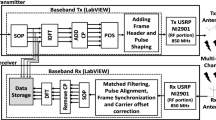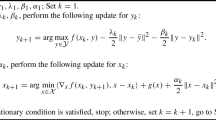Abstract
The blind adaptive multiuser detections based on higher-order statistics (HOS) can obtain higher steady-state decorrelating performance than the conventional linear algorithm under the high SNR condition. However, the closed-form analysis for this steady-state performance is scarce due to the complication of analyzing the nonlinear updates of the adaptive algorithm. An analysis approach based on ordinary differential equation (ODE) method is proposed to get the closed-form excess mean-square error (EMSE) expression of the HOS-based multiuser detections. The simulation and the comparison verify the results of the analysis.
Similar content being viewed by others
References
Miguez J, Castedo L. A linearly constrained constant modulus approach to blind adaptive multiuser interference suppression. IEEE Commun Lett, 1998, 2(8): 217–219
Walach E, Widrow B. The least mean fourth (LMF) adaptive algorithm and its family. IEEE Trans Inf Theory, 1984, 30(2): 275–283
Papadias C B. Globally convergent blind source separation based on a multiuser kurtosis maximization criterion. IEEE Trans Signal Process, 2000, 48(12): 3508–3519
Tang Z Q, Yang Z X, Pan C Y. A new blind multiuser detector based on LMK criterion (in Chinese). J Electr, 2000, 28(4): 40–42
Miyajima T. Blind adaptive detection using differential CMA for CDMA systems. IEICE Trans A, 2000, J83(A): 1318–1329
Zheng L, Ouyang S. An adaptive blind multiuser detection based on constraint least mean fourth (in Chinese). J Electr, 2006, 34(9): 1631–1634
Whitehead J B, Takawira F. Performance analysis of the linearly constrained constant modulus algorithm-based multiuser detector. IEEE Trans Signal Process, 2005, 53(2): 643–653
Tanrikulu O, Gonstantinides A G. The LMK algorithm with time varying forgetting factor for adaptive system identification in additive output noise. In: Proceedings of IEEE International Conference on Acoustics, Speech, and Signal Processing, vol 3. New York: IEEE Press, 1996. 1850–1853
Solo V, Kong X. Adaptive Signal Processing Algorithms: Stability and Performance. Upper Saddle River, NJ: Prentice Hall, Inc. 1995
Zhang X D. Modern Signal Processing (in Chinese). 2nd ed. Beijing: Tsinghua Press, 2002. 269–270
Author information
Authors and Affiliations
Corresponding author
Additional information
Supported by the National Natural Science Foundation of China (Grant No. 60432040), and the Guangxi Natural Science Foundation (Grant Nos. 0731026, 0731025)
Rights and permissions
About this article
Cite this article
Zheng, L., Qiu, H., Ge, W. et al. Steady-state performance analysis of HOS-based blind adaptive multiuser detection. Sci. China Ser. F-Inf. Sci. 52, 1243–1249 (2009). https://doi.org/10.1007/s11432-009-0112-y
Received:
Accepted:
Published:
Issue Date:
DOI: https://doi.org/10.1007/s11432-009-0112-y




